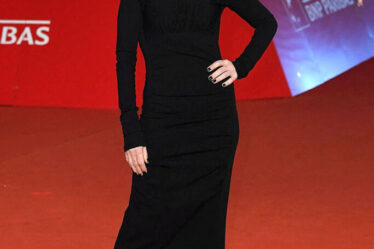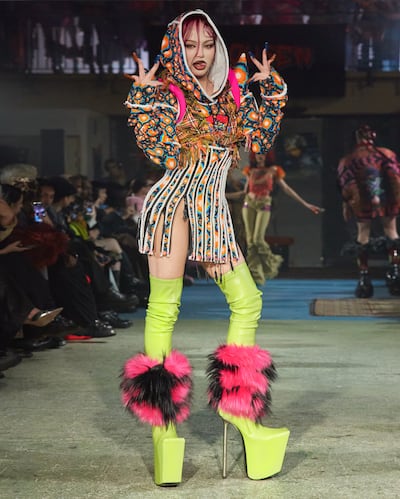
Since the turn of this century, the fashion industry has seen a steady rise in the number of Chinese designers emerging from overseas universities, appearing on fashion week schedules and being nominated for prestigious design awards. At the same time, Shanghai Fashion Week’s steady ascent has helped highlight China’s role not only as a consumer powerhouse but also as a creative design hub, one that attracts buyers from around the world.
“In the past, we’ve had some exceptional names come through on the global scene such as Uma Wang and Sankuanz, but now we are seeing an explosion of creatives who all offer something fresh and innovative to the market — and they can run a business too,” said Yeli Gu, founder of Shanghai-based fashion trade show Ontime. “The positive international business achievements these designers have made collectively in recent years is remarkable and should not be underestimated.”
But the internationalisation of Chinese brands hasn’t always been an easy journey, according to industry figures. Brandon Wen, creative director of the fashion department at the Royal Academy of Fine Arts Antwerp, says that the reality for nearly all young designers is they “suffer from the same dance of marrying the commercial and creative,” but on top of this, Chinese designers have to “circumnavigate cultural differences” which are unique to them.
“The struggle of Chinese designers is having to deal with the west, without [always] having [sufficient] context for it. They have to contend with how they are perceived in the west, aim to be welcomed there and then understand how Europeans conduct business [since the global industry is] so focused around that market. It’s about learning and doing the dance of another,” he continued.
Following an absence on the world stage during the pandemic when many bolstered their domestic businesses, Chinese designers are now firmly back on the international runway and trade show circuit, increasingly embedded in global business networks. On the Paris Fashion Week calendar, for example, several women-led brands are making their presence known, from Rui and Caroline Hu to Didu and Ruohan.
The footprint of Chinese designers’ supply chains is also increasingly global, with many extending their production and sourcing beyond traditional hubs like China and Western Europe to locations in India, Turkey and Czechia. In terms of distribution, multi-brand stores and e-tailers around the world have started stocking Chinese names. Feng Chen Wang alone sells to retailers in countries as far afield as Kuwait, Mexico, Romania, Malaysia and Israel.
Meanwhile, another group of Chinese designers — those who were either born outside China or lived much of their lives overseas but choose to base their businesses in the country — are taking inspiration from cosmopolitan lifestyles while exploring new notions of Chinese-ness in their designs and brand identities.
Take Ya Yi, a Spanish-born LVMH Prize nominee who spent ten years in Madrid, nine years in Shanghai and nine years in New York. Her business is registered in both the US and Spain but its main office is now in China where she shows at Shanghai Fashion Week. By embracing her dual heritage in the eponymous brand’s designs, “Ya Yi is pushing the boundaries of fashion,” said Marie Geneviève Cyr, director of the BFA fashion design programme at Parsons School of Design.
The globetrotting nature of twenty-first century Chinese designers should not be surprising to most observers but the international reach of their businesses may well be. Here, BoF offers a snapshot of eight ways they are upping their global quotient of their businesses, from the factory floor to the shop floor and beyond.
Windowsen’s Sensen Lii: Dressing K-pop Stars and Hollywood Celebrities
Cardi B went viral for all the wrong reasons after this year’s Met Gala when she neglected to name-check Sensen Lii, the designer behind her lavish, gothic look for the red carpet. In reality, he is hard to forget. Few designers have such an outlandish aesthetic as the Chengdu-born designer.
Lii’s ‘post-humanist’ designs for Windowsen have been worn by western celebrities like Madonna, Rihanna, Katy Perry, Doja Cat, Charli XCX, FKA Twigs and Grimes among others. Chinese actress Fan Bingbing was an early supporter of the brand but celebrities across Asia are now said to be fans including members of K-pop bands Le Sserafim and Blackpink and Cantopop singer Sammi Cheng.
According to Wen, Lii is one of the few designers from mainland China who has “really focused on his creative identity and aesthetic.”
Feng Chen Wang: a Retail Network Spanning Mexico, Malaysia and the Middle East
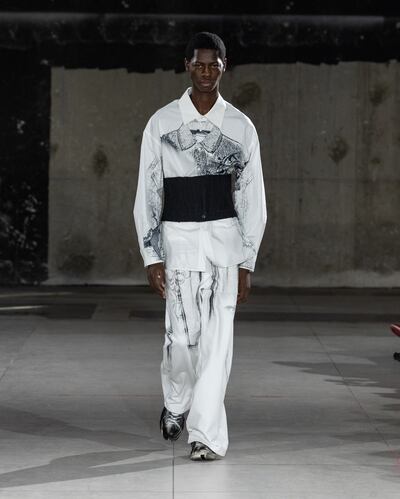
Based between London and Shanghai, the eponymous designer now has a staff of 35 with production concentrated in China. Over the years, Wang has built an impressive wholesale network in Asia and Europe, but she has grown her stockist list even further in recent years. Today it spans multi-brand stores as far afield as Mexico, Malaysia and the Middle East. In the latter region alone, she is sold in markets as diverse as Kuwait, Israel and the Dubai.
“We think what sets Feng’s work apart from other designers we buy is her ability to give a new perspective to deconstruction and reconstruction — in a very contemporary way. That, in combination with taking traditional stories, abstracted yet realised in unexpected details gives the audience new stories to discover. It gives the garments a soul beyond simply the cool zeitgeist aesthetic,” said Bobby Chehrazi, founder of multi-brand menswear retailer Closet Case in Dubai, the United Arab Emirates.
China’s industry leaders have dubbed the Fujian-native as the country’s ‘queen of international collaborations’, citing partnerships with North American titans Nike, Levi’s, Converse, Crocs, Ugg and Canada Goose to name a few. She was even tapped by Piaggio to create a special edition of the Italian company’s first eclectic scooter.
PH5′s Wei Lin: Anchoring a Chinese-Australian Duo in New York
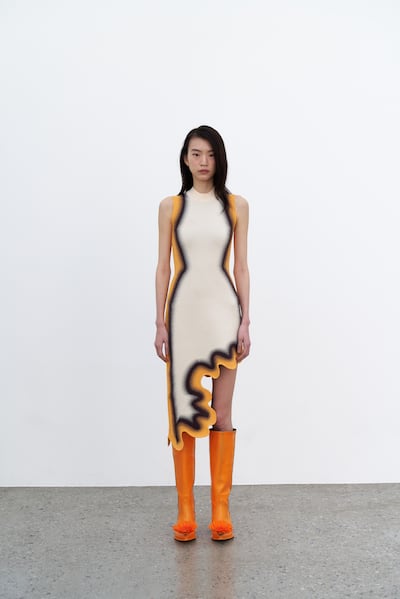
Knitwear brand PH5 was founded in New York in 2014 by Fujian-born Wei Lin. Produced largely in Dongguan, China, it has become even more international in scope in recent years, to the point that Lin says it’s getting harder to justify the ‘Chinese designer’ tagline to shareholders. Under the creative direction of Australian designer Zoe Champion who joined in 2020, PH5 shows at New York Fashion Week.
Using a pop-up strategy with exclusive retailers to connect with fans from the US to Kuwait, the brand is currently in London hosting a pop-up at Harvey Nichols until mid-November. Lucrezia Batignani, buyer of womenswear, advanced, contemporary and denim at Harvey Nichols told BoF that PH5 offers a product that is “unique in the marketplace” and that customers respond well to it due to its inclusivity, price point and flattering silhouettes.
“When so many brands exist, both old and new, competing in the market with a similar product mix, it’s refreshing to see something so different. It’s truly a brand that has its own identity that isn’t trend-led. That makes for a compelling proposition,” Batignani confirmed.
Didu’s Di Du: Fronting a New ‘Chinese Wave’ of Creativity in Paris
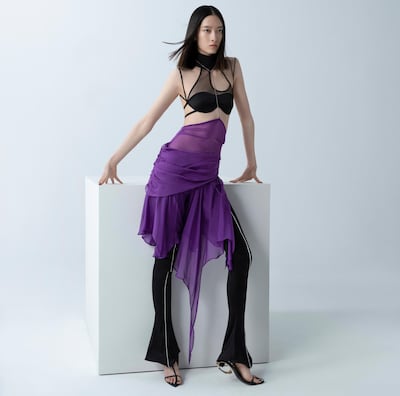
Part of a niche group of designers who have graduated from Belgium’s Royal Academy of Fine Arts in Antwerp, Di Du moved to Paris in 2022 where she has since showed at Paris Fashion Week and Sphere, the Fédération de la Haute Couture et de la Mode’s curated showroom for emerging designers. Du, who was featured on the German e-tailer Mytheresa’s China Designer Programme in 2023, calls her aesthetic “controversial” and believes it empowers Chinese women.
Xuzhou-born Du is part of a new China wave of creativity in Paris that is gaining speed in the 2020s, following waves of other overseas designers in the French capital such as the Japanese wave of the 1980s and the British wave of the 1990s, said Serge Carreira, director of the emerging brands initiative at the Fédération de la Haute Couture et de la Mode.
“Didu is part of this generation of designers who are rooted in Chinese culture but fully embracing our times and are very global in their message, commitment and aesthetic. And she’s attracting a younger audience that is certainly freer in terms of identity,” Carreira explained.
Ruohan: Appealing to Fashion Editors from the Baltics to Bulgaria
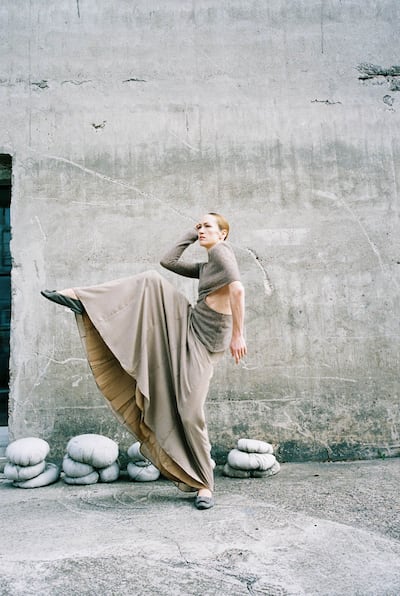
Ruohan Nie is one the youngest Chinese designers and the newest brands on the international scene. Hailing from Tianjin, Nie founded her timeless, craft-led brand Ruohan in 2021 following an education at Parsons School of Design. In just three years, she managed to build a solid business in China.
Now showing at Paris Fashion Week, Nie has garnered a slew of international press coverage to help boost her global marketing efforts. As well as appearing in rites-of-passage titles like Elle France, the brand has featured in publications from emerging markets around the world including Grazia Bulgaria, Marie Claire Mexico and L’Officiel Baltic.
Off the back of her increasingly international profile, Nie secured a nomination for the latest Andam Prize, a French fashion design award which she says, given her youth, has added to her confidence as a designer. Stefano Martinetto, CEO of Tomorrow, who is on the judging panel, praised her unique attention to detail. “She’s an amazing curator and everything she does is well thought out,” he said.
Samuel Gui Yang: Building a Network of Suppliers across the British Isles
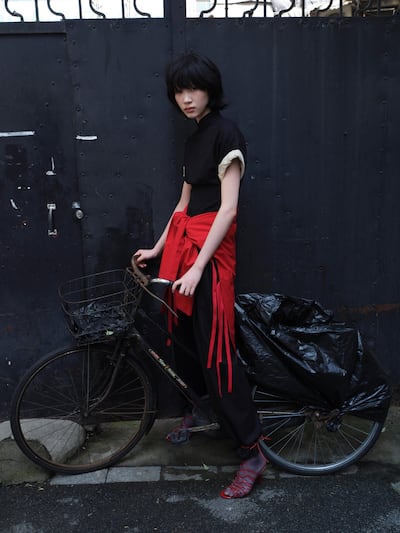
From his London studio, Shenzhen-born Samuel Gui Yang and his partner Erik Litzén, are focusing on manufacturing in the British Isles in order to nearshore some of the brand’s classic pieces. They are also sourcing materials locally such as wool fabrics from Cloudwool in Suffolk and deadstock from the Lochcarron mill in Scotland.
“They certainly had their fingers on the pulse. I’d been looking to find a designer who could take the fabric as it was and work with its properties to transform it into something beautiful. Yang’s done that,” said Martin Brambley, founder of Cloudwool.
The brand, which was shortlisted for the LVMH Prize in 2020, has been at the forefront of a style that blends China’s traditions with modernity, one that’s earning him fans back home and attention from international buyers. Currently, the brand is preparing for an October show at Shanghai Fashion Week.
Shuting Qiu: Producing Embroidery in India and Jacquard in Turkey

Another graduate from Belgium’s Royal Academy of Fine Arts in Antwerp — a school where she now sponsors an award of her own — is Shuting Qiu. Unlike her contemporaries, she opted for the Milan Fashion Week schedule from September 2019. Qiu, who hails from China’s traditional silk centre Hangzhou, is now decamping to Paris where she plans to open a studio, having just showcased an off-schedule runway show during fashion week in the French capital.
Qiu, also an LVMH Prize nominee, sources from luxury production hubs in Italy and France as well as from further afield — namely jacquard from Turkey and embroidery from India.
Ayush Murarka, founder of Ventures Kolkata, a manufacturer that has partnered with international designers for over 30 years, started working with Qiu when she was a student. “Shuting appreciates different crafts from all over the world and understands the uniqueness of India when it comes to a specialised skill like embroidery,” said Murarka, suggesting that Qiu international outlook is why she has gained recognition from such a wide range of overseas stockists. “If you want to be recognised globally — not just in one part of the world — you should be globally accepting of design [yourself].”
Susan Fang: Creating Cosmopolitan Campaigns from Iceland to Tanzania
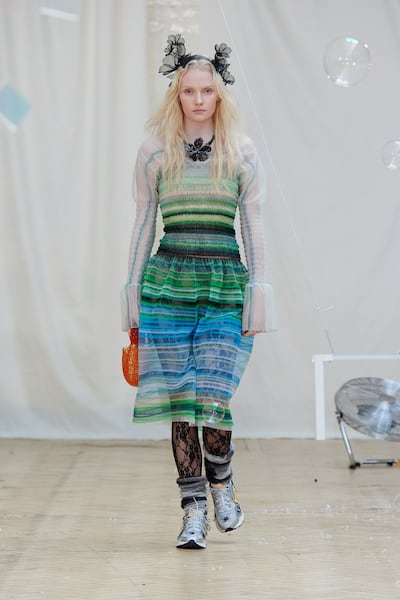
A graduate of the womenswear degree programme at Central Saint Martins, Susan Fang spends her time between the UK and China. Known for her material and fabric choices, Fang is a partner of Nova, sourcing deadstock from Europe, a relationship which according to journalist Susanna Lau, has resulted in an instantly recognisable aesthetic the world over.
“Susan Fang has a really strong signature in her textile techniques and she doesn’t deviate from that,” Lau said. “It’s stridently ethereal and doesn’t rely on keying into wavering trends. Her pieces really just look like ‘her’ instantly without [you] even knowing what it is.”
Fang said her international sales are growing around the world primarily in the US, Europe and Japan. Japan and South Korea started to take off at the end of the pandemic and a recent collaboration with Sweden’s H&M Group owned brand & Other Stories sold out quickly in the Korea market.
The cosmopolitan designer from Ningbo makes sure her marketing imagery has an international bent too. Recent campaign and lookbook shoots include those shot in Mexico and Tanzania where she asks local residents to model. This season will see her travel to use the dramatic landscapes of Iceland as her backdrop.


